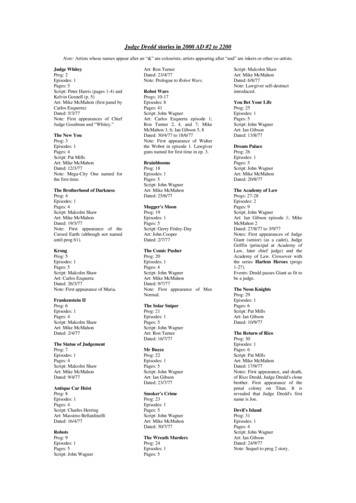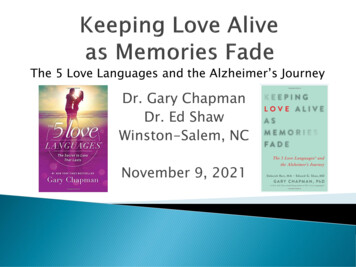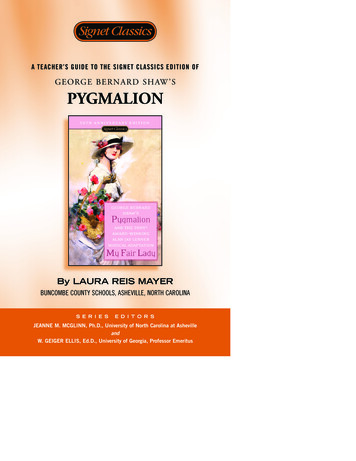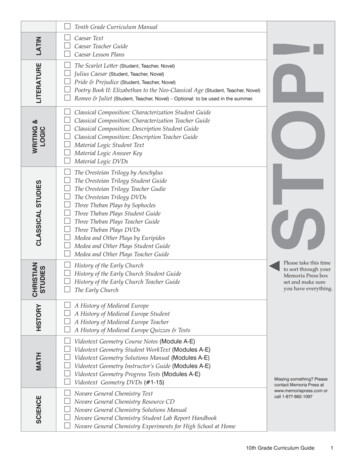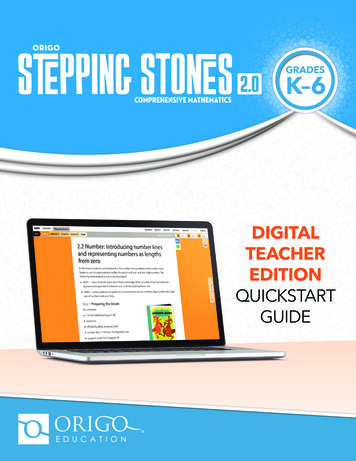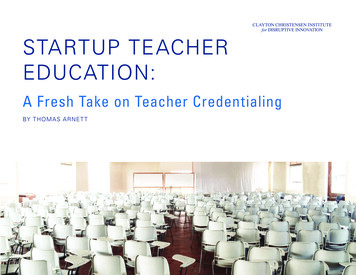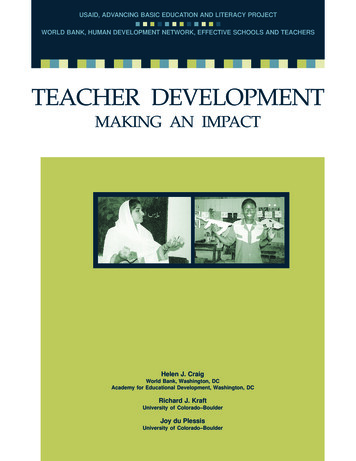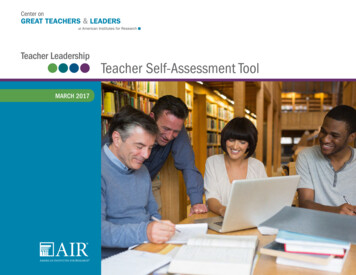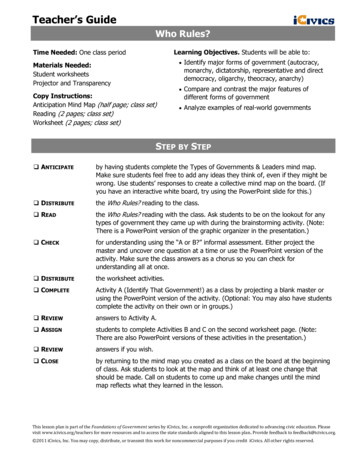
Transcription
Teacher’s GuideWho Rules?Learning Objectives. Students will be able to:Time Needed: One class period Identify major forms of government (autocracy,Materials Needed:Student worksheetsProjector and Transparencymonarchy, dictatorship, representative and directdemocracy, oligarchy, theocracy, anarchy)Copy Instructions:Anticipation Mind Map (half page; class set)Reading (2 pages; class set)Worksheet (2 pages; class set) Compare and contrast the major features ofdifferent forms of government Analyze examples of real-world governmentsSTEP BY STEP ANTICIPATEby having students complete the Types of Governments & Leaders mind map.Make sure students feel free to add any ideas they think of, even if they might bewrong. Use students’ responses to create a collective mind map on the board. (Ifyou have an interactive white board, try using the PowerPoint slide for this.) DISTRIBUTEthe Who Rules? reading to the class. READthe Who Rules? reading with the class. Ask students to be on the lookout for anytypes of government they came up with during the brainstorming activity. (Note:There is a PowerPoint version of the graphic organizer in the presentation.) CHECKfor understanding using the “A or B?” informal assessment. Either project themaster and uncover one question at a time or use the PowerPoint version of theactivity. Make sure the class answers as a chorus so you can check forunderstanding all at once. DISTRIBUTEthe worksheet activities. COMPLETEActivity A (Identify That Government!) as a class by projecting a blank master orusing the PowerPoint version of the activity. (Optional: You may also have studentscomplete the activity on their own or in groups.) REVIEWanswers to Activity A. ASSIGNstudents to complete Activities B and C on the second worksheet page. (Note:There are also PowerPoint versions of these activities in the presentation.) REVIEWanswers if you wish. CLOSEby returning to the mind map you created as a class on the board at the beginningof class. Ask students to look at the map and think of at least one change thatshould be made. Call on students to come up and make changes until the mindmap reflects what they learned in the lesson.This lesson plan is part of the Foundations of Government series by iCivics, Inc. a nonprofit organization dedicated to advancing civic education. Pleasevisit www.icivics.org/teachers for more resources and to access the state standards aligned to this lesson plan. Provide feedback to feedback@icivics.org. 2011 iCivics, Inc. You may copy, distribute, or transmit this work for noncommercial purposes if you credit iCivics. All other rights reserved.
Who Rules?Name:Types of Governments. What kinds of governments exist? What kinds of leaders can be in charge of acountry? Think about everything you’ve ever heard of or learned and add it to this mind map. Circle eachidea you add and draw a line to connect it to the main phrase (or to another idea you added). Keepbrainstorming until you run out of room or time.Anticipation Activity – Mind MapWho Rules?Name:Types of Governments. What kinds of governments exist? What kinds of leaders can be in charge of acountry? Think about everything you’ve ever heard of or learned and add it to this mind map. Circle eachidea you add and draw a line to connect it to the main phrase (or to another idea you added). Keepbrainstorming until you run out of room or time.Anticipation Activity – Mind Map
Who Rules?Name:Someone’s Got to Be In ChargeIf you compared all the governments in the world, you would find onething in common: Someone is in charge. The question is, who? Thereare many different forms of government. Some have one leader whohas all the control. Others give power to the people. Here are someforms of government that exist (or have existed) in the world:Me, Myself, and IAn autocracy is a government in which one person has all thepower. There are two main types of autocracy: a monarchy and adictatorship.In a monarchy, a king or queen rules the country. The king orqueen is known as a monarch. Monarchs usually come to powerthrough their family line: The current king or queen’s oldest childbecomes the next king or queen. In some monarchies, especiallythose in historical times, the monarch held all the power and hadthe final say over the government. In modern times, monarchsusually share power with other parts of government. Often they arealso subject to the country’s constitution.King Harald V of Norway with his wife,Queen Sonja. Norway is a constitutionalmonarchy. The king is the head of stateand has a mainly ceremonial role. Theactual government is a democracy.A dictatorship is a form of government where one leader hasabsolute control over citizens’ lives. If there is a constitution, thedictator has control over that, too—so it doesn’t mean much.Although other parts of the government may exist, such as courts ora lawmaking body, these branches always do what the dictatorwants them to do. They do not represent citizens.Power to the People!In a democracy, citizens hold the political power. There are twofundamental types of democracies:In a representative democracy, citizens elect leaders torepresent their rights and interests in government. The electedleaders, or representatives, do the day-to-day work of governingthe country: They consider the issues, work to find solutions, passlaws, and do all of the other things necessary to keep a countrygoing. Citizens hold the ultimate power, though, because if theydon’t like what their representatives are doing, they can vote in newones!In a direct democracy, there are no representatives. Citizens aredirectly involved in the day-to-day work of governing the country.Citizens might be required to participate in lawmaking or act asjudges, for example. The best example of this was in the ancientGreek city-state called Athens. Most modern countries are too largefor a direct democracy to work.A man votes in Peru.The Peruvian legislatureReading p.1
Who Rules?Name:We, Ourselves, and um UsIn an oligarchy (OH-lih-gar-kee), a small group of people has allthe power. Oligarchy is a Greek word that means “rule by a few.”Sometimes this means that only a certain group has politicalrights, such as members of one political party, one social class, orone race. For example, in some societies, only noble families whoowned land could participate in politics. An oligarchy can alsomean that a few people control the country. For example, ajunta is a small group of people—usually military officers—whorule a country after taking it over by force. A junta often operatesmuch like a dictatorship, except that several people share power.From 1962 to 2011, Myanmar (also knownas Burma) was ruled by a military juntathat was condemned by the world for itshuman rights violations.Religious RuleCrown of the Holy Roman Empire,which was tied to the Catholic churchand lasted from the 10th—19th century.A theocracy is a government that recognizes God or a divine beingas the ultimate authority. (“Theo” is a Greek word that means god.)In a theocracy, religious law is used to settle disputes and rule thepeople. A theocracy can also be a democracy, dictatorship, monarchy,or just about any other kind of government. For example, theRepublic of Iran recognizes Islamic law, but Iran’s citizens vote toelect their leaders. Modern theocracies are usually found in countrieswhere the population is strongly religious.Rule by NoneIn an anarchy, nobody is in control—or everyone is, depending on howyou look at it. Sometimes the word anarchy is used to refer to an out-ofcontrol mob. When it comes to government, anarchy would be one wayto describe the human state of existence before any governmentsdeveloped. It would be similar to the way animals live in the wild, witheveryone looking out for themselves. Today, people who call themselvesanarchists usually believe that people should be allowed to freelyassociate together without being subject to any nation or government.There are no countries that have anarchy as their form of government.AAn A inside a circle is the traditionalsymbol for anarchy. Where would you put theocracy on this chart?Reading p.2
Who Rules?Name:A. Identify That Government! Identify the form(s) of government that each country has or had.Forms of government:andForms of government:andForms of government:Form of government:andForms of government:Form of government:andWorksheet p.1
Who Rules?Name:B. True or False? Use what you learned in the reading and in Exercise A to fill in the chart below. C. Vocabulary. Solve the crossword puzzle using vocabulary from the reading.123Across3. Type of democracy where citizens electleaders to represent them in government7. A small group that rules a country aftertaking it over by force459. One person has all the power610. Type of democracy where citizens areinvolved in day-to-day government7Down81. Recognizes God as the ultimate authorityin government and law2. One leader has absolute control overcitizens’ lives9104. Citizens hold the political power5. A small group of people has all the power6. People are not subject to any nation orgovernment8. A king or queen rules the countryWorksheet p.2
Who Rules?** TEACHER GUIDE **Informal Assessment: A or B?Directions: Read each statement aloud, or project and uncover each statement individually. Have theclass answer “A” or “B” as a chorus. Listen for a mix of answers, indicating confusion. Use each questionas a chance to quickly review concepts before moving on.AB1. One person is in charge.AutocracyDemocracy2. Citizens often have no rights.DemocracyDictatorship3. Can exist with other forms ofgovernmentDictatorshipTheocracy4. Led by a king or queenMonarchyOligarchy5. Nobody is in chargeMonarchyAnarchy6. Those in charge are military memberswho took over by forceJuntaDemocracy7. Leader often shares power with otherparts of governmentMonarchyDictatorship8. Democracy where citizens elect othersto serve in . A small group rules the countryOligarchyDemocracy11. People do not answer to any leaderor governmentOligarchyAnarchy12. God and religious law are thegovernment’s authorityTheocracyAnarchy13. The group with power can be basedon race or social classMonarchyOligarchy14. Democracy where citizens participatein lawmaking themselvesDirectRepresentative9. Citizens vote to elect their leaders.Informal Assessment Master
Who Rules?** TEACHER GUIDE **Informal Assessment: A or B?Directions: Read each statement aloud, or project and uncover each statement individually. Have theclass answer “A” or “B” as a chorus. Listen for a mix of answers, indicating confusion. Use each questionas a chance to quickly review concepts before moving on.AB1. One person is in charge.AutocracyDemocracy2. Citizens often have no rights.DemocracyDictatorship3. Can exist with other forms ofgovernmentDictatorshipTheocracy4. Led by a king or queenMonarchyOligarchy5. Nobody is in chargeMonarchyAnarchy6. Those in charge are military memberswho took over by forceJuntaDemocracy7. Leader often shares power with otherparts of governmentMonarchyDictatorship8. Democracy where citizens elect othersto serve in . A small group rules the countryOligarchyDemocracy11. People do not answer to any leaderor governmentOligarchyAnarchy12. God and religious law are thegovernment’s authorityTheocracyAnarchy13. The group with power can be basedon race or social classMonarchyOligarchy14. Democracy where citizens participatein lawmaking themselvesDirectRepresentative9. Citizens vote to elect their leaders.Informal Assessment Master
Who Rules?Name:** TEACHER GUIDE **A. Identify That Government! Identify the form(s) of government that each country has or had.Forms of government:RepresentativedemocracyandDirect DemocracyForms of government:OligarchyandRepresentative DemocracyForms of government:Form of government:DictatorshipMonarchyandTheocracyForms of government:MonarchyForm of government:Representative democracyandRepresentative democracyWorksheet p.1
Who Rules?Name:** TEACHER GUIDE **B. True or False? Use what you learned in the reading and Exercise A to fill in the chart below.Denmark: Monarch is part ofa democracy; Saudia Arabia: Monarch hascomplete control.You can’t have a democracyif citizens have no control, which they do not ina dictatorship. Switzerland hadrepresentative and direct characteristics. South Africa was anoligarchy but had some representativedemocracy.A monarchy has someone incontrol. Nobody is in control with anarchy. Saudia Arabia is a monarchy and a theocracy. Iran is a theocracy wherecitizens vote for government leaders. A military junta like the onein Myanmar can function like a dictatorship.C. Vocabulary. Solve the crossword puzzle using vocabulary from the . One person has all the powerARAROCYCAOCRRRNHSYHOCRACHRYYCHYCETGTVAOUH7. A small group that rules a country aftertaking it over by forceI8M9A10D3. Type of democracy where citizens electleaders to represent them in governmentIP10. Type of democracy where citizens areinvolved in day-to-day governmentDown1. Recognizes God as the ultimate authorityin government and law2. One leader has absolute control overcitizens’ livesRECT4. Citizens hold the political power5. A small group of people has all the power6. People are not subject to any nation orgovernment8. A king or queen rules the countryWorksheet p.2
9. One person has all the power 10. Type of democracy where citizens are involved in day-to-day government Down 1. Recognizes God as the ultimate authority in government and law 2. One leader has absolute control over citizens' lives9 4. Citizens hold the political power 5. A small group of people has all the power 6.
